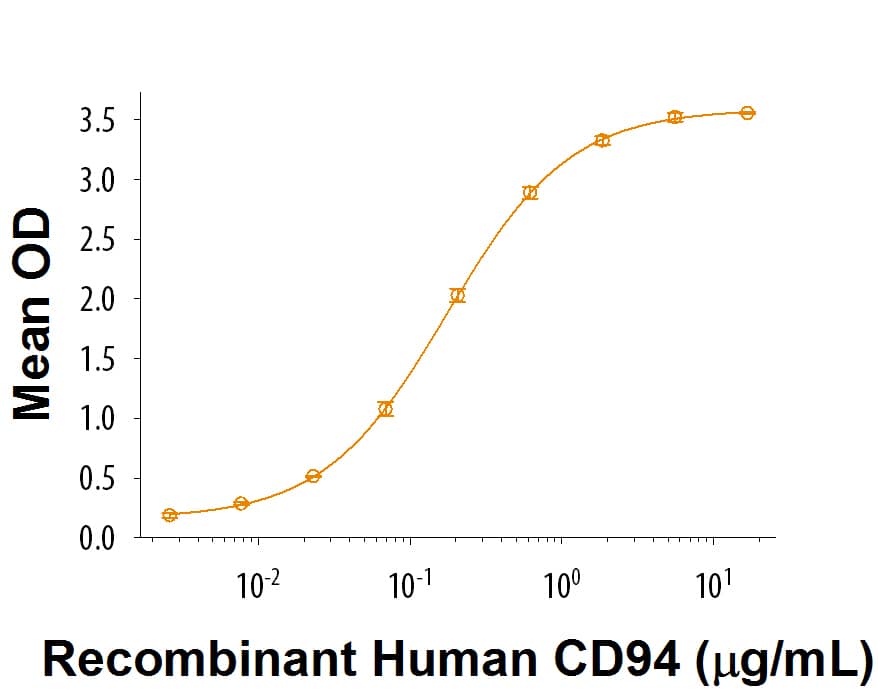Recombinant Mouse NKG2A (CHO-expressed) Fc Protein, CF
R&D Systems, part of Bio-Techne | Catalog # 9198-NK

Key Product Details
Source
CHO
Accession #
Structure / Form
Disulfide-linked homodimer
Conjugate
Unconjugated
Applications
Bioactivity
Product Specifications
Source
Chinese Hamster Ovary cell line, CHO-derived mouse NKG2A/CD159a protein
| MDP | Mouse IgG2A (Glu98-Lys330) |
IEGR | Mouse NKG2A (Ala94-IIe244) Accession # Q9Z202 |
| N-terminus | C-terminus | ||
Purity
>95%, by SDS-PAGE visualized with Silver Staining and quantitative densitometry by Coomassie® Blue Staining.
Endotoxin Level
<0.10 EU per 1 μg of the protein by the LAL method.
N-terminal Sequence Analysis
Met
Predicted Molecular Mass
44 kDa
SDS-PAGE
58-67 kDa, reducing conditions
Activity
Measured by its binding ability in a functional ELISA.
When Recombinant Mouse NKG2A/CD159a Fc Chimera is coated at 0.5 µg/mL, recombinant human CD94 binds with a typical ED50 of
0.1-0.6 μg/mL.
When Recombinant Mouse NKG2A/CD159a Fc Chimera is coated at 0.5 µg/mL, recombinant human CD94 binds with a typical ED50 of
0.1-0.6 μg/mL.
Scientific Data Images for Recombinant Mouse NKG2A (CHO-expressed) Fc Protein, CF
Recombinant Mouse NKG2A (CHO-expressed) Fc Protein Bioactivity
When Recombinant Mouse NKG2A Fc Chimera (Catalog # 9198-NK) is coated at 0.5 μg/mL, recombinant human CD94 binds with a typical ED50 of 0.1-0.6 μg/mL.Formulation, Preparation and Storage
9198-NK
| Formulation | Lyophilized from a 0.2 μm filtered solution in PBS. |
| Reconstitution |
Reconstitute at 500 μg/mL in PBS.
|
| Shipping | The product is shipped at ambient temperature. Upon receipt, store it immediately at the temperature recommended below. |
| Stability & Storage | Use a manual defrost freezer and avoid repeated freeze-thaw cycles.
|
Background: NKG2A/CD159a
References
- Das, J. and S.I. Khakoo (2015) Immunol. Rev. 267:214.
- Vance, R.E. et al. (1998) J. Exp. Med. 188:1841.
- Saez-Borderias, A. et al. (2009) J. Immunol.182:829.
- Houchins, J.P. et al. (1997) J. Immunol. 158:3603.
- Brooks, A.G. et al. (1997) J. Exp. Med. 185:795.
- Zhou, J. et al. (2008) J. Immunol. 180:25.
- Braud, V.M. et al. (1998) Nature 391:795.
- Carretero, M. et al. (1997) Eur. J. Immunol. 27:563.
- Lee, N. et al. (1998) Proc. Natl. Acad. Sci. USA 95:5199.
- Tomasec, P. et al. (2000) Science 287:1031.
- Brooks, C.R. et al. (2006) J. Immunol. 176:1141.
Long Name
Natural Killer G2A
Alternate Names
CD159a, Klrc1, NKG2
Gene Symbol
KLRC1
UniProt
Additional NKG2A/CD159a Products
Product Documents for Recombinant Mouse NKG2A (CHO-expressed) Fc Protein, CF
Product Specific Notices for Recombinant Mouse NKG2A (CHO-expressed) Fc Protein, CF
For research use only
